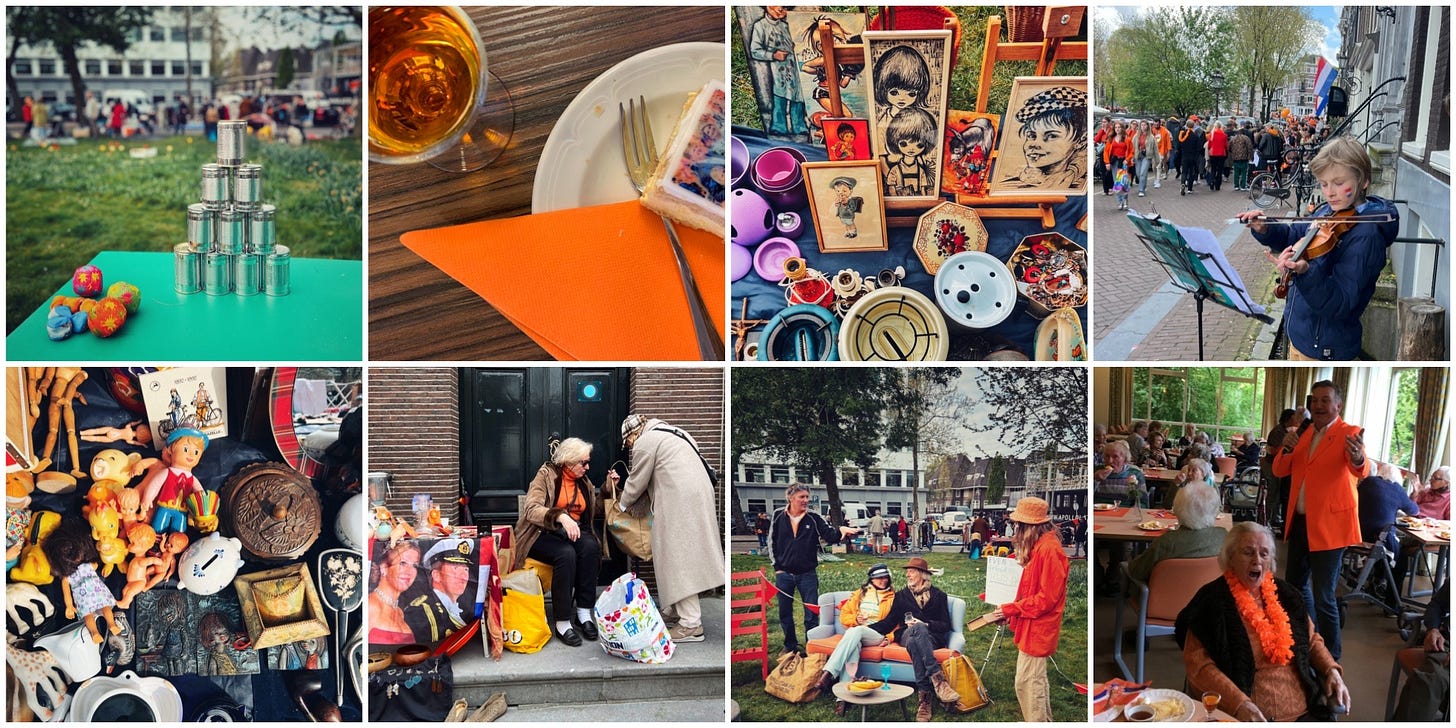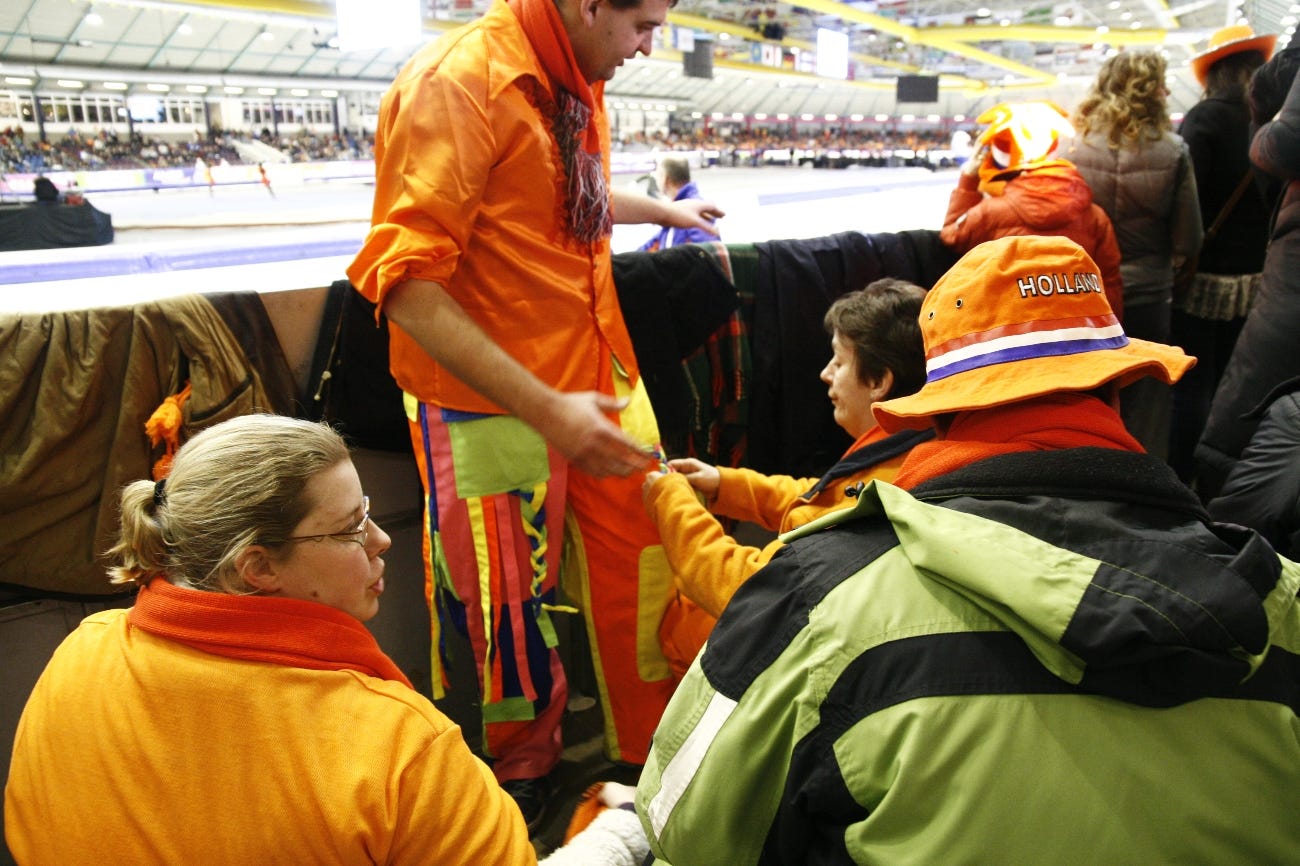That bright colour makes us easy to recognise. We are the cheery sports fans, the ones dressing in orange for national holidays and the ones selling orange merch to tourists 🤑.
With King's Day and Liberation Day on the calendar, let's take a deep dive into the colour orange and explore the phenomenon of 'orange fever'.
Yes, it is a colour 🍊
Orange is when you mix red and yellow, but the etymology teaches us that the fruit we know as orange is the name-giver of the colour.
The word 'orange' originates from the Sanskrit 'nāranga', travelling through Persian, Arabic, Spanish ('naranja') and French before reaching English. The fruit named the colour, not vice versa.
Oranges in Dutch are called sinaasappels, which has a different origin - it literally means 'China's apple', referring to its origin (sina = China, appel = apple) and does have a nickname 'appeltjes van oranje' (which means apples of orange. Did I already mention Dutch is a weird language?)
Oranjebitter
Oranges are the main ingredient in Oranjebitter (a liquor) and oranjekoek (cake made with orange peels). You can drink it as a shot, but it can also be used as an ingredient for a Dutch Spritz or a Dutch Negroni (yes, why not).
The Dutch twist on the Negroni: Use 30 ml Jenever1, 30 ml Oranjebitter and 30 ml sweet Red Vermouth and stir with ice before straining into a rocks glass. Garnish with orange peel or a slice of orange.
But it’s a Royal colour!
The colour orange comes from the Dutch royal House of Orange-Nassau, named after the Principality of Orange (pronounced as or-AHN-zh) in southern France. Willem I (also known as Willem the Silent), who inherited this territory in 1544, became a national hero by leading the Dutch Revolt against Spanish rule.
The original Dutch flag had an orange stripe instead of red. This “Prince's Flag” with its orange-white-blue design evolved over time. During World War II, the flag's history took a dark turn when Dutch Nazi sympathisers used the older orange version. These complex historical events ultimately established the red-white-blue tricolour 🇳🇱 we know today. Despite these shifts, orange remains the vibrant colour of royal celebrations and passionate national sporting events.
Our current king Willem-Alexander (formerly known as Prins Pils) is a huge sports fan. He attends many football and hockey matches and can often be found cheering on the field after a win. So if you're looking for a Royal of Orange with genuine orange fever, this is your guy.
Royal places for your itinerary:
Paleis Het Loo (Apeldoorn) is a former royal residence now operating as a museum with beautiful gardens. It has recently been renovated.
Paleis Noordeinde (The Hague) is the working palace where only the gardens are open to the public. The palace interior remains closed, but you can visit it virtually.
Palace Soestdijk (Baarn) is a former royal residence currently under renovation, though exhibitions are regularly held there.
Drakensteyn Castle (Lage Vuursche) is Princess Beatrix's private residence. The surroundings are amazing. Public access is limited to walking or cycling around the estate using public paths.
The Nieuwe Kerk (Delft) contains the royal burial vault, including William of Orange's tomb, and hosts Royal Family exhibitions.
Long live King’s Day
Without bothering you too much with all the history, still a brief introduction. We celebrate the King’s birthday on King’s Day, which falls on 27 April. However, this year it will be held on the 26th, as the event is not held on Sundays for practical and religious reasons.
But it becomes even more confusing 👑
Before we celebrated Queen's Day on 30 April. It was the birthday of the Queen's mother (former Queen Juliana). Her daughter Beatrix, who ascended to the throne in 1980, decided to maintain Queen's Day in April, despite her own birthday being on 31 January. King Willem-Alexander shifted the holiday to his birthday, 27 April.
In the first years after his inauguration, some tourists (relying on outdated guidebooks) didn't realise the date had changed. There was even a Missed The Boat Party organised for the ‘vergistoeristen’.
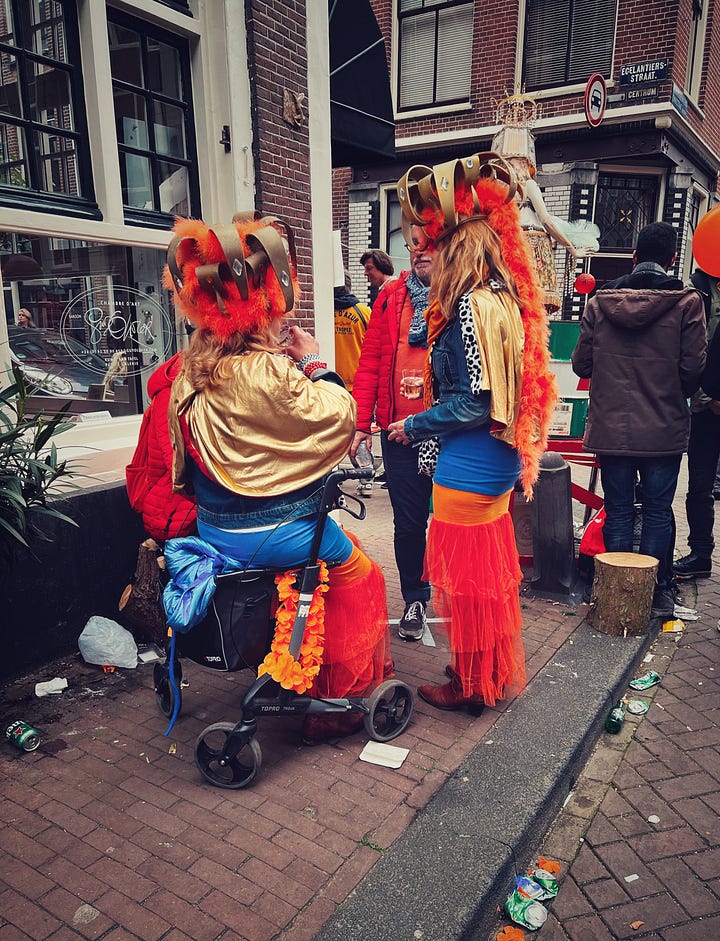

Liberation Day
King's Day is the sole annual public holiday in the Netherlands without a Christian origin. (Apparently, we still require a second day of Easter for aimlessly wandering through shopping centres.)
Liberation Day is a public holiday only every five years because it fell too close to Queen's Day. However, as it coincides with school holidays, numerous events still occur yearly, primarily targeting children and teenagers. This year, as it's 2025, it will be a public holiday on 5 May.
Orange in every corner 🔸
King's Day is celebrated in virtually every corner of the Netherlands - not just in Amsterdam. All cities, villages, islands, regions, and neighbourhoods host their own King's Day celebrations. Even the most dreary square or park can transform into a festive orange zone on that day.
The evening before, King's Night is celebrated in some Dutch cities. The event in Utrecht is particularly renowned because the flea market opens that evening.
My King’s Day
There are numerous ways to celebrate the day, and I can speak from personal experience. It's not always fun. I’ve hated the day at times (and I still do when I’m queueing for a toilet for 30 minutes or more).
As a child, I sold items, watched the royal family and discussed their outfits with my grandmother, or I observed boy scouts performing dull rope tricks in Almelo's city centre. I attended day festivals, spent entire days on terraces during sunny weather, and visited Amsterdam without a clear destination, frustrated by the crowds.
I wandered through Rotterdam with friends, I had a significant hangover and remained indoors for most of the day, I was ditched by a friend for another gathering, or was abroad travelling.
For numerous years, I sold items on the street with a friend and made kids happy with free bits and pieces; sometimes just an orange balloon. I discovered a wedding dress on the street and put it on, or was fortunate enough to board a boat in Amsterdam's canals.
I performed voluntary work in a nursing home (occasionally challenging to maintain a cheerful smile for the grannies after the previous night's activities), joined a street choir, danced on a picnic table, and unexpectedly ended up in a fetish bar.
People-watching
However, the vrijmarkt (flea market) and people-watching remain my preferred activities on King's Day.
I try to arrive at the vrijmarkt early morning, although that can be a challenge. As early as possible is optimal for finding exceptional items, but it's still entertaining throughout the day. I enjoy observing people's old stuff, buying a coffee and a snack from kids, and searching for unique objects. Afterwards, I proceed to Amsterdam's city centre, meet friends, and explore spontaneously. There's plenty to do without much planning.
Skip Amsterdam!2
As mentioned, Amsterdam isn't the sole location for celebrating the King's Birthday. Consider alternative historic cities easily accessible by train. What about Leiden, Amersfoort, Haarlem, Zutphen, Deventer, Breda, or Zwolle for King's Day?
Not interested in flea markets and amateur musicians? You can join one of the many festivals.
It’s also a fever 🦁
They say the fever started in 1974. When the Netherlands, with football legends like Cruijff and Neeskens, was facing West Germany in the World Cup final. And lost. Dutch football became famous, and orange as well.
But nowadays, it is way different.
First, there was the big drought after 1978 (another lost final and a controversial one as well), no tournaments at all and some not-so-memorable Olympic appearances (there are a few exceptions, of course).
But then it became 1988.
1988
It started with the three golden medals of Yvonne van Gennip in Calgary. Of course, with speed skating - duh. Then, as a prelude for the summer, PSV won the European Cup 1 for the first and only time. In June 1988, orange became huge friends with the fever.
After a rough start, 'we' reached the semi-final. But 'we' didn't have any orange merchandise at that moment, no flags, no silly hats, no wuppies or lions. We decorated our house with a tent canvas (tents were orange back then) and turned the house upside down for orange accessories and clothing.
The Netherlands won the European Championship ⚽️ with Marco van Basten as the absolute hero. 1988 became a milestone in so many lives. And now people feel old when they realise they have vivid memories of that time.
Speed Skating 🥇
After that year, the confidence was back, and we were bombarded with orange merchandise more and more (even orange vuvuzelas in 2010). And not only during football tournaments (like the World Cup in 1998 with the goal of Dennis Bergkamp), but also during the Olympics.
In 1996, the male volleyball team won gold in Atlanta, and many refer to this as a pivotal moment in Dutch sports history that made their orange hearts beat faster. I recall watching the final during a family holiday at a campsite in France. The other guests stared at us as if we were a group of crazy loud Dutch supporters, cheering and celebrating with unbridled enthusiasm.
Dutch sports results and victories do look like a cyclical movement sometimes. This does not only apply to football but also to that other national sport: speed skating. The Dutch skaters win a lot (with Ireen Wüst on top of the Olympus) or win a little. Which is good for the sport, of course. The best arena to attend speed skating is in Thialf, Heerenveen, where people dressed in orange gather to watch the athletes doing their rounds while they drink Beerenburg and sing along with hoempapa music.
It is spreading
Orange fever is spreading. Not only did the men win the European Championship in football, but the women did as well. In 2017, when the tournament was in the Netherlands. And what about F1 - Max is attracting a whole new orange army, especially when they race around in Zandvoort.
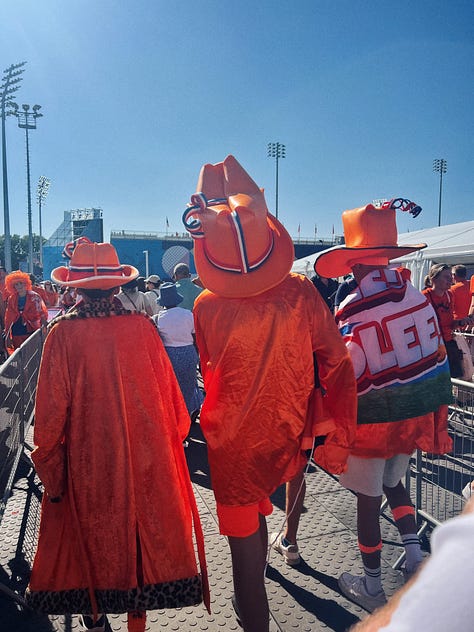
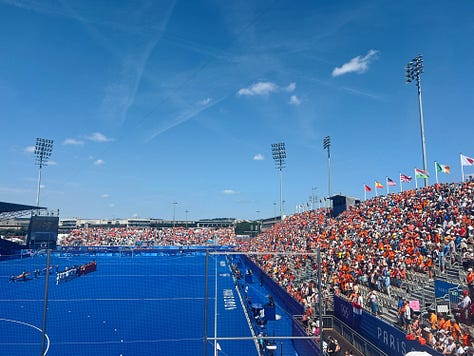

The Dutch field hockey teams both won gold in Paris last year, and the stadium was filled with orange – a good contrast with the blue of the field. During my stay in Paris, it was easy and fun to spot the fans and say hello. I made it to national television with my Airbnb on the cycling race route with my silly orange balloons and my orange outfit, cheering for Marianne Vos.
Wear it with pride 🧡
Although it is not really my colour with my pale skin.
Read, watch, listen & for your agenda
Join one of the Liberation Festivals across the Netherlands on 5 May
Talking about Liberation Day - some films about the Second World War in the Netherlands: Soldier of Orange, Black Book, A Bridge Too Far (about Operation Market Garden), and Oscar-winner The Assault (watchable on YouTube).
One of those movies is also known as the longest-running musical in the Netherlands: Soldier of Orange has been running since 2010.
The Dutch football team will compete in the Women’s EURO 2025 in Switzerland, starting on 2 July. Tickets are still available!
To give you an idea of the Orange sports fans. Read some fun articles about Dutch supporters during EURO 2024: ‘Pounding music, thudding bodies, flares and fun – marching with the Netherlands’ orange army‘ (The Athletic) and ‘You Are Cordially Invited to Euro 2024’s Best Party. Please Wear Orange.’ (The New York Times).
Be a supporter of Orange and sing along:
Uitsmijter
This is how the European Championship was celebrated in 1988.
There are even people from Amsterdam fleeing the city and the crowds this weekend.






